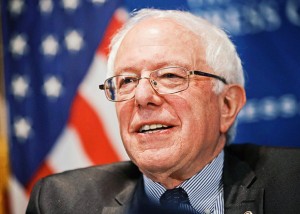Neoliberal Economists Attack Bernie Sanders
How to Pay for Single Payer Universal Health Care Program by means of a financial transactions tax

As U.S. presidential candidate Bernie Sanders has gained momentum in the presidential primaries, the attacks on his proposed economic programs have grown proportionally.
Leading the assault have been supporters of Hillary Clinton, especially Paul Krugman, and other “stars” of the economics profession like Christine Romer, Laura Tyson, Alan Kreuger, and Austan Goolsbe — all of whom have served in past Democratic administrations and are no doubt looking to return again in some capacity in another Clinton administration. Sometimes referred to as the “gang of four,” in recent weeks all have been aggressively attacking Sanders’ economic programs and reforms. However, the target of their attacks, which began in February and continue today, is Sanders’ proposals for financing a single-payer universal health care program by means of a financial transactions tax.
The irony of the Krugman/Gang of Four attack is that Sanders’ proposals represent what were once Democratic party positions and programs — positions that have been abandoned by the party and its mouthpiece economists since the 1980s as it morphed into a wing of the neoliberal agenda.
Sanders’ critics have been especially agitated that their own economic models are being used to show that Sanders’ proposals would greatly benefit the vast majority in the U.S. But debating Krugman and his neoliberal colleagues on the grounds of their faulty economic model — a model that failed miserably under Obama to produce a sustained, real economic recovery in the U.S. — is not necessary. Their model has been broken for some time. Some straightforward historical facts and recent comparative studies are all that’s need to show that a real financial transaction tax can generate more revenue than is needed to fund a single-payer type program. Here’s how.
A Real Financial Transaction Tax
Let’s take four major financial securities: stocks, bonds, derivatives, and foreign currency purchases (forex).
A European study a few years ago involving just 11 countries, whose collective economies are about two-thirds the size of the U.S. economy, concluded that a miniscule financial tax of 0.1 percent on stocks and bonds plus a virtually negligible 0.01 percent tax on derivatives results in an annual tax revenue of US$47 billion. In an equivalent size U.S economy that would be about US$70 billion in revenue a year.
 Wealthy investors’ buying of stocks and bonds is essentially no different than average folks buying food, clothing or other real ‘goods and services’. Why shouldn’t investors pay a sales tax on financial securities purchases? In the U.S., average households pay a sales tax of 5 percent to 10 percent for retail purchases of goods and many services. So why shouldn’t wealthy investors pay a similar sales tax rate for their retail financial securities’ purchases?
Wealthy investors’ buying of stocks and bonds is essentially no different than average folks buying food, clothing or other real ‘goods and services’. Why shouldn’t investors pay a sales tax on financial securities purchases? In the U.S., average households pay a sales tax of 5 percent to 10 percent for retail purchases of goods and many services. So why shouldn’t wealthy investors pay a similar sales tax rate for their retail financial securities’ purchases?
A 10 percent “sales tax” on stock and bond buying and a 1 percent tax on derivatives amounts to a 100x larger tax revenue take than estimated by the European study. The US$70 billion estimated based on the European study’s 0.1 percent stock-bond tax and 0.01 percent derivatives tax yields US$7 trillion in tax revenue with a 10 percent and 1 percent tax on stocks and bonds and derivatives.
Too high, Krugman and the Gang of Four would no doubt argue. Wealthy stock and bond buyers should not have to pay that much. It would stifle raising capital for companies. Okay. So let’s lower it to half, to 5 percent tax on stocks and bonds and 0.5 percent on derivatives. That reduces the US$7 trillion tax revenue to a still huge US$3.5 trillion annually.
Still too high? Okay, half it again, to a 2.5 percent tax on stocks and bonds and a 0.25 percent on derivative trades. That certainly won’t discourage stock and bond trading by the rich (not that that is an all bad idea either). The 2.5 percent and 1 percent tax still produces US$1.75 trillion a year in revenue.
But what about an additional financial tax on currency trading, like China is about to propose? Currency, or forex, trades amount to an astounding US$400 billion each day! Not all that is U.S. currency trading, of course. However, the U.S. dollar is involved in 87 percent of the trading. A 1 percent tax on U.S. currency trades conservatively yields approximately US$3 billion a day. Assuming a conservative 220 trading days in a year, US$3 billion a day produces US$660 billion in financial tax revenue from U.S. currency financial transactions in a year.
US$1.75 trillion in revenue from stock, bonds, and derivatives trades, plus another US$660 billion in forex trade tax revenue, amounts to US$2.41 trillion in total revenue raised from a financial transaction tax of 2.5 percent on stocks and bonds, 0.25 percent on derivatives, and 1 percent on U.S. dollar to currency conversions.
So how much will that US$2.41 trillion a year cover is needed to fund a single payer-Medicare for All program in the US?
Paying for Single Payer Health Care
Nearly every advanced economy in the world provides a version of single payer health care to its citizens—except the U.S. On the other hand, no country spends as much on health care as the US. The UK spends 9 percent of GDP, Japan about 10 percent, France and Germany 11 percent, for example. The U.S., in contrast, pays 17 percent plus of its GDP on health care. Given that the most recent US GDP is about US$18 trillion a year, 17 percent of US$18 trillion equals just over US$3 trillion a year.
If the U.S. spent, like other advanced economies with single payer, about 10 percent of its GDP a year on health care, it would cost US$1.8 trillion instead of US$3 trillion a year. The U.S. would save US$1.2 trillion.
Where does that current US$1.2 trillion go? Not for health services for its citizens. It goes to health insurance companies and other “middlemen,” who don’t deliver one iota of health care services. They are the “paper pushers” who skim off US$1.2 trillion a year in profits that average returns of 20 percent a year and more. They are economic parasites, or what economists refer to as “rentier capitalists” who don’t produce anything but suck profits and wages from those who do actually produce something. They then used the US$1.2 trillion a year to buy up each other, expand globally, and deliver record dividend and stock buybacks for their shareholders.
In other words, a true financial transactions tax, that is still quite reasonable at tax rates of 0.25 percent to 2.5 percent, can pay for all of a single-payer health care program in the U.S. and still have hundreds of billions left over — US$641 billion to be exact (US$2.41 minus US$1.8 trillion).
That US$641 billion residual could then be used to better fund current Medicare programs. It could eliminate the current 20 percent charge for Medicare Part B physicians services and provide totally free Part D prescription drugs for everyone over 65 years. The savings for seniors over 65 years from this, and the tens of thousands of dollars saved every year by working families who now have to pay that amount for private company health insurance, would now be freed up with a single payer system, to be spent on other real goods and services.
A financial transaction tax and single payer program would consequently have the added positive effect of creating the greatest boost in real wages and household income, and therefore consumption, in US economic history. More consumer demand would mean more real investment.
Yes, there would be less spending by the wealth speculating in stocks, bonds, derivatives, forex and other financial securities. But so what? If rich and wealthy investors don’t like that, well then let them eat cake — or some other four letter word.
Jack Rasmus is author of the just published book, “Systemic Fragility in the Global Economy,” by Clarity Press, 2016. He blogs at jackrasmus.com.

